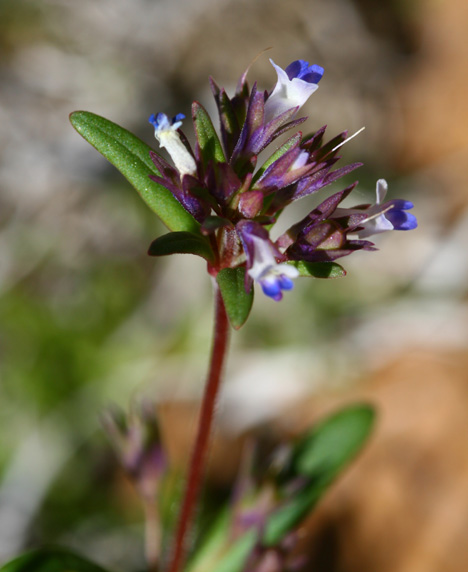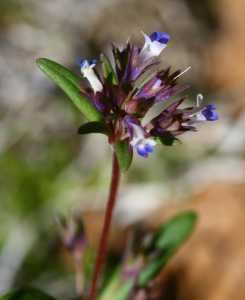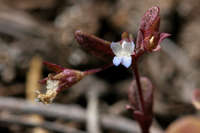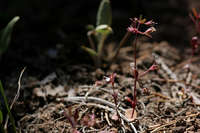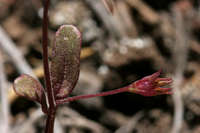General: Annual, 5-40 cm tall; stems decumbent, ascending, or sometimes erect, simple or branched, reddish purple; herbage puberulent, often glandular above and glabrous below; taprooted.
Leaves: Cauline, opposite or sometimes whorled, oblanceolate, mostly 1.5-3 cm long, 3-5 mm wide, often green above and purplish beneath, margins entire, occasionally with a pair of teeth towards the apex, lowermost cauline blades orbicular, much reduced; lowermost blades petiolate, upper blades sessile, blades connected by a line around the stem.
Flowers: Inflorescence a spike-like raceme, initially dense, becoming elongated, pale yellow, villous and glandular- puberulent; bracts broadly lanceolate to ovate, margins entire or sometimes with a pair of lateral lobes near the apex; calyx 1.3-2.3 cm long, cleft into 2 lateral primary lobes, more deeply cleft in front (8-13 mm) than in back (6-10 mm); corolla tubular, 1.8-3 cm long, the galea 6-12 mm long, the lower lip 1-2.5 mm long, the teeth short, blunt, ciliate; flowers June-August.
Fruits: Capsule, septicidal and loculicidal, ovoid or elliptical, 3-5.5 mm long, the style usually persistent; seeds 2 per locule, small, brown.
Ecology: Sagebrush communities, pinyon-juniper woodlands, aspen stands, ponderosa pine and spruce-fir forests; 900-2700 m (3000-9000 ft); Apache, Coconino, Gila, Graham, Mohave, Navajo, Pima, Pinal, and Yavapai counties; central and western Canada, central, wester
Notes: A spring ephemeral, Collinsia parviflora is often difficult to distinguish from other small annuals as the growing season progresses. Several species bear similarities, and are differentiated as follows: in Mimulus rubellus the lowest leaves are wide-lanceolate; in Heliomeris multiflora the lowest leaves are rounded but the surfaces bear appressed pubescence; in Epilobium brachycarpum the leaves are linear, usually with minute teeth along the length of the margin.
Editor: Springer et al. 2008
Erect, 1-4 dm, often branched from the base; cauline lvs linear to narrowly oblong, 1-3 cm, entire or nearly so, narrowed below to a petiolar base; lowest fls solitary, upper in whorls of 2-6 on slender pedicels 5-15 mm; cal-lobes lance-linear, acuminate, 2.5-4 mm; cor barely surpassing the cal-lobes; upper lip usually white or whitish, the lower blue; cor-lobes oblong-spatulate, not retuse; filaments all glabrous; seeds 2; 2n=14. Sterile rocky soil; widespread in the w. cordillera, e. to Man. and w. Neb.; n. Mich.; also s. Ont., Vt., and N.S., where probably only intr. May-July.
Gleason, Henry A. & Cronquist, Arthur J. 1991. Manual of vascular plants of northeastern United States and adjacent Canada. lxxv + 910 pp.
©The New York Botanical Garden. All rights reserved. Used by permission.


